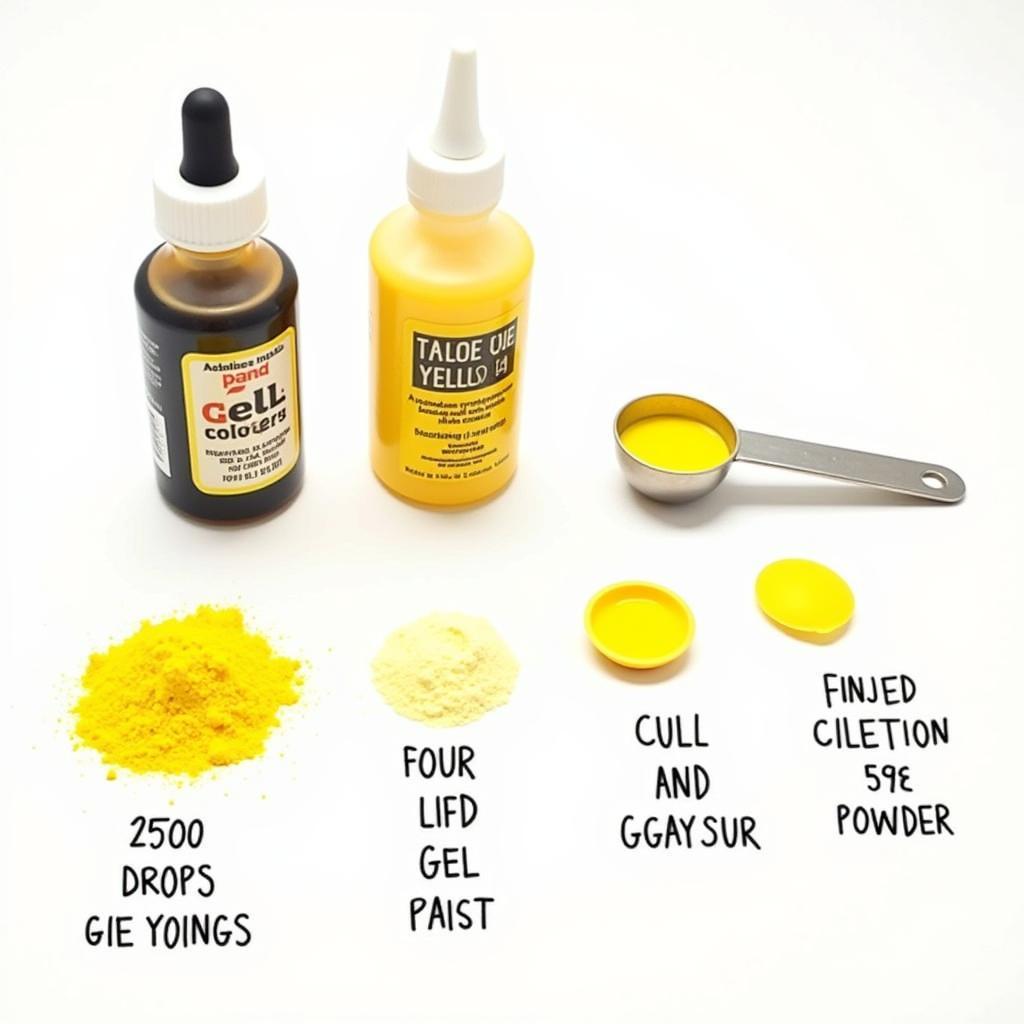Egg Yellow Food Colouring is a popular choice for bakers and home cooks looking to add a sunny hue to their creations. From vibrant cakes and cookies to creamy custards and frostings, this colouring agent offers a simple way to enhance the visual appeal of a wide range of dishes. But what exactly is egg yellow food colouring, and how can you use it effectively? This comprehensive guide will explore everything you need to know about achieving that perfect yellow shade in your culinary adventures.
Whether you’re a seasoned baker or just starting out, understanding the nuances of food colouring can elevate your baking game. While lemon yellow food colour offers a brighter, citrusy hue, egg yellow food colouring offers a softer, more pastel tone that’s perfect for mimicking the natural colour of egg yolks in desserts. Let’s delve deeper into the world of egg yellow food colouring and discover its versatility.
Understanding Egg Yellow Food Colouring
Egg yellow food colouring often aims to replicate the warm, rich colour of egg yolks. This makes it a go-to choice for recipes where a natural-looking yellow is desired. Think classic vanilla cakes, creamy custards, and even homemade pasta dough. Its gentle hue avoids the sometimes artificial-looking vibrancy of other yellow food colourings. What are the different types of egg yellow food colouring available? You’ll commonly find liquid and gel-based options. Each has its own advantages, and understanding these differences can help you choose the best one for your needs.
What about natural alternatives? For those seeking a more natural approach, natural food colouring powder like turmeric can create a beautiful, warm yellow. However, be mindful of the potential flavour impact that natural colourings can impart.
 Types of Egg Yellow Food Colouring
Types of Egg Yellow Food Colouring
How to Use Egg Yellow Food Colouring Effectively
How much egg yellow food colouring should you use? Start with a small amount and gradually add more until you achieve the desired shade. Remember, it’s always easier to add more colour than to take it away. Over-colouring can result in an unappetizingly intense hue. Test the colour on a small portion of your batter or frosting before adding it to the entire batch.
Different recipes react differently to food colouring. Factors like the fat content and other ingredients can influence the final colour. What about achieving specific shades? Experimenting with different amounts of colouring will help you achieve shades ranging from pale pastel yellow to a rich, golden hue.
 Adding Egg Yellow Food Colouring to Batter
Adding Egg Yellow Food Colouring to Batter
Tips and Tricks for the Perfect Yellow
Want to avoid streaks and uneven colouring? Mix your egg yellow food colouring thoroughly into your batter or frosting. For liquid colourings, use a toothpick to add a drop at a time, ensuring even distribution. For gel-based colourings, a spatula or butter knife can be helpful for incorporating the colour. What about achieving vibrant, consistent results? Always follow the manufacturer’s instructions for best results. Different brands may have varying concentrations of colour, so it’s essential to refer to the packaging.
Consider using white or light-coloured bases for your recipes to allow the egg yellow food colouring to shine through. Darker bases can muddy the final colour, making it difficult to achieve that vibrant yellow you desire. Need a deeper yellow? Combining egg yellow with a touch of orange food colouring can create a richer, more golden hue.
Egg Yellow Food Colouring: Beyond Baking
While often associated with baking, egg yellow food colouring can be used in various culinary applications. From vibrant sauces and dips to colourful pasta dough and even playdough for kids, the possibilities are endless. Thinking outside the box can open up a world of creative culinary opportunities. Want to add a pop of colour to savoury dishes? Egg yellow food colouring can be used to brighten sauces, especially those with a creamy base. Imagine a vibrant yellow hollandaise sauce or a sunny-hued aioli.
Looking for food dye purple? Combining various food colourings can create a wide range of colours, so you’re not limited to just yellow.
Conclusion
Egg yellow food colouring offers a versatile and easy way to add a touch of sunshine to your culinary creations. From delicate pastries to vibrant savoury dishes, its applications are vast and limited only by your imagination. By understanding the nuances of using this colouring agent, you can achieve consistent, vibrant results every time. So, go ahead and experiment with egg yellow food colouring to create visually stunning dishes that are sure to impress.
FAQ
- Is egg yellow food colouring safe to consume? Yes, commercially available egg yellow food colouring is generally safe for consumption when used as directed.
- Can I use natural alternatives to egg yellow food colouring? Yes, turmeric and saffron are natural alternatives that can produce a yellow hue.
- How do I store egg yellow food colouring? Store in a cool, dark place away from direct sunlight.
- What if I add too much egg yellow food colouring? It’s difficult to remove excess colouring, so start with a small amount and gradually add more.
- Can I use egg yellow food colouring in cold dishes? Yes, egg yellow food colouring can be used in both hot and cold dishes.
- Does egg yellow food colouring have a taste? Most commercial egg yellow food colourings are flavourless.
- Where can I buy egg yellow food colouring? You can find it in most supermarkets, baking supply stores, and online.
Need support? Contact us at Phone Number: 02437655121, Email: minacones@gmail.com Or visit us at: 3PGH+8R9, ĐT70A, thôn Trung, Bắc Từ Liêm, Hà Nội, Việt Nam. We have a 24/7 customer service team.